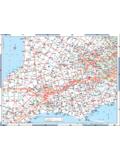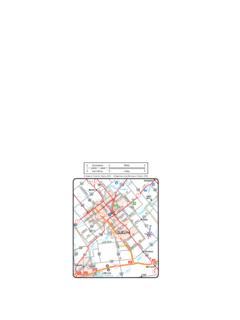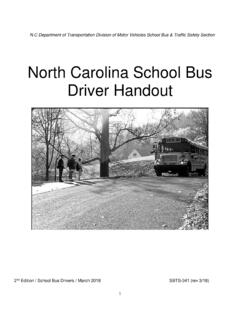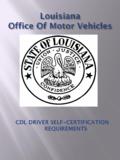Transcription of COMMERCIAL VEHICLE OPERATORS SAFETY ANUAL
1 COMMERCIAL VEHICLE OPERATORS SAFETY MANUAL COMMERCIAL VEHICLE OPERATORS SAFETY Manual Table of Contents Module 1 - Introduction .. 1-1 Module 2 Getting Started .. 2-1 Module 3 Ontario Legislation and the National SAFETY Code .. 3-1 Module 4 COMMERCIAL VEHICLE OPERATORS Registration .. 4-1 Module 5 Ontario Specific Enforcement Issues .. 5-1 Module 6 Facility Audit and Operator Monitoring and Intervention .. 6-1 Module 7 SAFETY Programs, Record-Keeping and Driver Files .. 7-1 Module 8 Preventive Maintenance, Record-Keeping and VEHICLE Files .. 8-1 Module 9 Hours of Service .. 9-1 Module 10 Dangerous Goods .. 10-1 Module 11 VEHICLE Weights and Dimensions .. 11-1 Module 12 Driver and VEHICLE Licensing.
2 12-1 Module 13 Passenger Transportation Services .. 13-1 Module 14 Cargo Securement .. 14-1 Module 15 Terms of Reference .. 15-1 Ontario COMMERCIAL Motor- VEHICLE OPERATORS SAFETY Manual Module 1 - Introduction Overview .. 1-2 Purpose of this Guide .. 1-3 Queen s Printer Bookstore .. 1-4 Intended Users .. 1-5 Highlight of Modules Available in this Manual .. 1-6 Introduction March 2012 1-1 Overview The Carrier SAFETY and Enforcement Branch of the Ministry of Transportation of Ontario has prepared this guide to assist and ensure that truck and bus companies ( COMMERCIAL - VEHICLE OPERATORS ) operate safely and are compliant with the regulations that govern highway use. Ontario, other provinces, the Government of Canada and the transportation industry developed the rules and regulations to help reduce the number and severity of collisions.
3 Each jurisdiction has used the National SAFETY Code standards as guides in drafting their own transportation SAFETY legislation. This approach promotes uniformity across Canada and helps to ensure that the transportation industry remains as viable and sustainable as possible. This guide applies to Ontario OPERATORS of COMMERCIAL motor vehicles that are: Trucks, tractors or trailers, or a combination of these vehicles, that have a registered gross VEHICLE weight or actual weight of more than 4,500 kilograms Buses with a manufactured seating capacity of 10 persons or more, excluding the driver Accessible vehicles and school-purposes vehicles, depending upon use The guide contains several modules, each dealing with a specific topic.
4 To get a complete picture of compliance requirements, you should obtain the complete guide. If you intend to use certain parts of this guide only (for example, Module 1, Getting Started ) it is recommended that you also obtain the modules Introduction and COMMERCIAL VEHICLE OPERATORS Registration. This is a guide only and is not meant to be a substitute for the relevant statutes and regulations. This guide highlights some important legal provisions but is not an exhaustive description of all the laws that apply. Introduction March 2012 1-2 Purpose of this Guide Ontario highways are shared by the public and by COMMERCIAL vehicles of all descriptions. Motorists have become more and more concerned about SAFETY as a result of increasing numbers of vehicles using the highways.
5 This increase, especially of heavier vehicles, contributes significantly to the wear and tear of the highway infrastructure. The Ministry of Transportation of Ontario is responsible for the province s highways, and is committed to making them safe, efficient and high quality. In support of that, the Carrier SAFETY Enforcement Branch of the ministry has prepared this guide to assist COMMERCIAL truck and bus OPERATORS to operate safely and to be compliant with the legislation that governs highway use. The main reason for developing this guide is to help OPERATORS and drivers operate COMMERCIAL motor vehicles efficiently and safely by understanding and complying with Ontario s legislative requirements. The use of this guide should increase compliance with SAFETY requirements, resulting in a more efficient and safe operation.
6 Specifically, this guide was developed to: STUDY GUIDE: Provide information for new COMMERCIAL VEHICLE OPERATORS Registration (CVOR) written Test. The CVOR test must be completed prior to obtaining a CVOR certificate. See details in Module 4 CVOR. Help existing and future drivers , managers and OPERATORS of truck and bus companies understand applicable legislation and safe operating procedures Encourage OPERATORS to abide by the legislation and to implement safe operating procedures Provide resources and contact information to current and future OPERATORS in Ontario, Canada and the United States Increase cooperation and understanding between industry and government Help OPERATORS develop, update and implement their SAFETY and maintenance programs Provide direction and information for new drivers and OPERATORS in the industry Introduction March 2012 1-3 This guide will assist OPERATORS in complying with the legislation and related regulations as follows: Highway Traffic Act (Ontario) Transportation of Dangerous Goods Act (Canada) Dangerous Goods Transportation Act Compulsory Automobile Insurance Act Public Vehicles Act Fuel Tax Act This guide is not meant to be a substitute for this legislation.
7 Copies of the relevant acts and regulations for Ontario are available at no cost from the Ontario e-Laws website1. Copies of the federal legislation are available from the federal government. Print Version of the COMMERCIAL VEHICLE OPERATORS SAFETY Manual A copy of the complete COMMERCIAL VEHICLE OPERATORS SAFETY manual can be saved or printed by clicking on the PDF document below or to print individual modules click the specific PDF link at the top of each page. The ministry does not produce printed versions of this manual. Introduction March 2012 1-4 Intended Users This guide is intended to assist: New OPERATORS in the highway transportation industry, including but not limited to, trucks that have a registered gross weight or actual weight of over 4,500 kilograms, and buses that can carry 10 or more passengers (excluding the driver) New OPERATORS preparing to complete the COMMERCIAL VEHICLE OPERATORS Registration (CVOR) written test.
8 Existing OPERATORS who need to have a clear understanding of their responsibilities, relevant acts, regulations and requirements Truck and bus OPERATORS who transport dangerous goods or have a specific requirement covered in this guide Maintenance staff who repair, maintain and test-drive COMMERCIAL vehicles SAFETY officers responsible for ensuring the safe operation of COMMERCIAL vehicles and driver SAFETY Staff responsible for ensuring that administrative procedures are identified and used Company management seeking to comply with legislative requirements Introduction March 2012 1-5 Highlight of Modules Available in this Manual # Title Description 1 Introduction Outline of the purpose of the COMMERCIAL VEHICLE OPERATORS SAFETY Manual and the intended users.
9 2 Getting Started Provides a summary of some of the items that must be addressed when setting up a truck or bus business, including: - writing a business plan - International Registration Plan (IRP) - International Fuel Tax Agreement (IFTA) 3 National SAFETY Code Provides a list of relevant standards and a summary of the 16 National SAFETY Codes for Canada and how they are adopted in Ontario. 4 COMMERCIAL VEHICLE OPERATORS Registration Provides a summary of the requirements under the COMMERCIAL VEHICLE OPERATORS Registration (CVOR). Identifies who needs to obtain a CVOR certificate and how to apply and how a carrier SAFETY rating is calculated. 5 Ontario Specific Enforcement Issues Provides information on enforcement issues that are specific to Ontario, including: - COMMERCIAL VEHICLE Impoundment Program (CVIP) - speed limiters 6 Facility Audit and Operator Monitoring and Intervention Provides details on how Ontario monitors, audits and applies sanctions to OPERATORS who are not meeting their SAFETY requirements.
10 7 SAFETY Programs Record-Keeping and Driver Files Provides best practices of record-keeping, hiring staff and developing a SAFETY program. Outlines the record-keeping requirements for driver files. 8 Preventive Maintenance, Record- Keeping and VEHICLE Files Provides details, sample report and requirements for VEHICLE maintenance and inspections. Includes: - Daily, annual, semi-annual and CVSA inspection - SAFETY standards certificates - Preventative maintenance - Out-of-province and OPERATORS 9 Hours of Service Describes Ontario requirements related to reducing driver fatigue. Outlines driving limitations, record-keeping requirements and an operator s responsibilities to be proactive and reactive with the monitoring of their drivers .
















